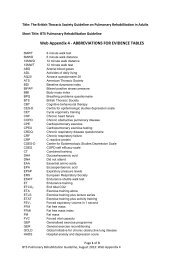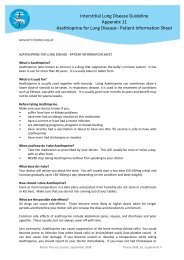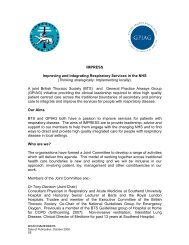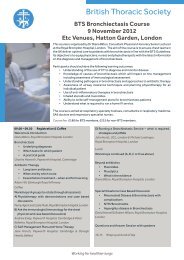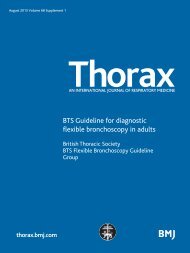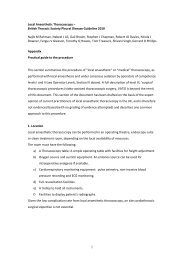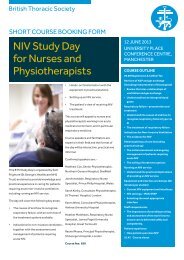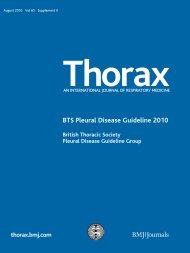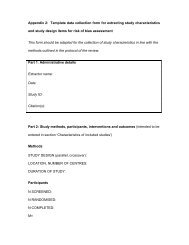Guidelines for the management of community ... - Brit Thoracic
Guidelines for the management of community ... - Brit Thoracic
Guidelines for the management of community ... - Brit Thoracic
You also want an ePaper? Increase the reach of your titles
YUMPU automatically turns print PDFs into web optimized ePapers that Google loves.
BTS guidelines<br />
practice <strong>for</strong> use in <strong>the</strong> assessment <strong>of</strong> patients who may have<br />
pneumonia and o<strong>the</strong>r acute respiratory illnesses. Oxygen<br />
saturation below 94% in a patient with CAP is an adverse<br />
prognostic feature and also an indication <strong>for</strong> oxygen <strong>the</strong>rapy, 309<br />
[IVb]<br />
which will usually require urgent referral to hospital.<br />
Patients who fall outside <strong>the</strong> low severity criteria <strong>for</strong> CAP<br />
should be assessed <strong>for</strong> <strong>the</strong> need <strong>for</strong> hospital referral (see Section<br />
6). Social factors will also play an important part in <strong>the</strong> decision<br />
to refer a patient to hospital. Patients with moderate or high<br />
severity pneumonia should be admitted to hospital and<br />
managed, where possible, with input from a physician with<br />
an interest in respiratory medicine.<br />
Recommendations<br />
c Patients with suspected CAP should be advised to rest,<br />
to drink plenty <strong>of</strong> fluids and not to smoke. [D]<br />
c Pleuritic pain should be relieved using simple analgesia<br />
such as paracetamol. [D]<br />
c The need <strong>for</strong> hospital referral should be assessed using<br />
<strong>the</strong> criteria recommended in section 6. [C]<br />
c Pulse oximetry, with appropriate training, should be<br />
available to general practitioners and o<strong>the</strong>rs responsible<br />
<strong>for</strong> <strong>the</strong> assessment <strong>of</strong> patients in <strong>the</strong> out-<strong>of</strong>-hours<br />
setting <strong>for</strong> <strong>the</strong> assessment <strong>of</strong> severity and oxygen<br />
requirement in patients with CAP and o<strong>the</strong>r acute<br />
respiratory illnesses. [D]<br />
Figure 7 Severity assessment <strong>of</strong> <strong>community</strong> acquired pneumonia<br />
(CAP) in patients seen in <strong>the</strong> <strong>community</strong> (CRB65 severity score plus<br />
clinical judgement). DBP, diastolic blood pressure; SBP, systolic blood<br />
pressure.<br />
anti-inflammatory drugs. Physio<strong>the</strong>rapy is <strong>of</strong> no proven benefit<br />
in acute pneumonia. 306 [III] Nutritional status appears important<br />
both to <strong>the</strong> outcome and <strong>the</strong> risk <strong>of</strong> acquiring pneumonia and,<br />
in prolonged illness, nutritional supplements may be helpful.<br />
Patients with pneumonia are <strong>of</strong>ten catabolic and those aged<br />
.55 years who are malnourished appear to be at greater risk <strong>of</strong><br />
150 307 [III] [III]<br />
developing pneumonia.<br />
Patients with pneumonia <strong>of</strong>ten become hypoxic because<br />
pulmonary blood flow takes place through unventilated lung<br />
tissue. The clinical signs <strong>of</strong> hypoxia are non-specific and <strong>of</strong>ten<br />
difficult to recognise in <strong>the</strong> early stages. They include altered<br />
mental state, dyspnoea and tachypnoea. Respiratory rate should<br />
<strong>the</strong>re<strong>for</strong>e always be assessed. Central cyanosis is unreliable both<br />
as a clinical sign and also as an indicator <strong>of</strong> tissue hypoxia. In<br />
contrast, pulse oximetry which measures arterial oxygen<br />
saturation (SpO 2 ) is, in most situations, a simple and reliable<br />
method <strong>of</strong> assessing oxygenation. However, poor peripheral<br />
perfusion, jaundice and pigmented skin can produce a falsely<br />
low saturation and carboxyhaemoglobin a falsely high saturation.<br />
Pulse oximetry is now widely available in North America.<br />
A survey <strong>of</strong> 944 outpatients and 1332 inpatients with evidence<br />
<strong>of</strong> CAP enrolled from five sites in <strong>the</strong> USA and Canada reported<br />
increasing assessment <strong>of</strong> arterial oxygen saturation with pulse<br />
oximetry in up to 58% <strong>of</strong> outpatients and 85% <strong>of</strong> inpatients. 308<br />
[II]<br />
It is recommended that pulse oximetry, with appropriate<br />
training, should become more widely available in general<br />
Thorax 2009;64(Suppl III):iii1–iii55. doi:10.1136/thx.2009.121434<br />
7.2 What review policy should be adopted in patients managed<br />
in <strong>the</strong> <strong>community</strong>?<br />
When to review a patient with CAP in <strong>the</strong> <strong>community</strong> will be<br />
determined by <strong>the</strong> initial severity assessment and o<strong>the</strong>r factors<br />
such as reliable help in <strong>the</strong> home. Patients assessed as being at<br />
low severity should improve on appropriate <strong>the</strong>rapy within<br />
48 h, at which time severity reassessment is recommended.<br />
Those who fail to improve within 48 h should be considered <strong>for</strong><br />
hospital admission. Patients who do not fulfil <strong>the</strong> criteria <strong>for</strong><br />
low severity and are being managed at home will require more<br />
frequent review.<br />
Recommendations<br />
c Review <strong>of</strong> patients in <strong>the</strong> <strong>community</strong> with CAP is<br />
recommended after 48 h or earlier if clinically indicated.<br />
Disease severity assessment should <strong>for</strong>m part <strong>of</strong><br />
<strong>the</strong> clinical review. [D]<br />
c Those who fail to improve after 48 h <strong>of</strong> treatment<br />
should be considered <strong>for</strong> hospital admission or chest<br />
radiography. [D]<br />
7.3 What general <strong>management</strong> strategy should be <strong>of</strong>fered to<br />
patients in hospital?<br />
Initial <strong>management</strong><br />
There is some evidence that use <strong>of</strong> a critical care pathway <strong>for</strong><br />
patients referred to hospital can reduce <strong>the</strong> hospital admission<br />
<strong>of</strong> low-risk patients and can also rationalise inpatient <strong>management</strong>.<br />
310 [Ib]<br />
All patients referred to hospital with CAP should have a chest<br />
radiograph (if not already per<strong>for</strong>med in <strong>the</strong> <strong>community</strong>) and<br />
should have oxygenation assessed by pulse oximetry, preferably<br />
while breathing air. Those with SpO 2 ,94% should have arterial<br />
blood gas measurements, as should all patients with features <strong>of</strong><br />
high severity pneumonia. Knowledge <strong>of</strong> <strong>the</strong> inspired oxygen<br />
concentration is essential to <strong>the</strong> interpretation <strong>of</strong> blood gas<br />
iii29



